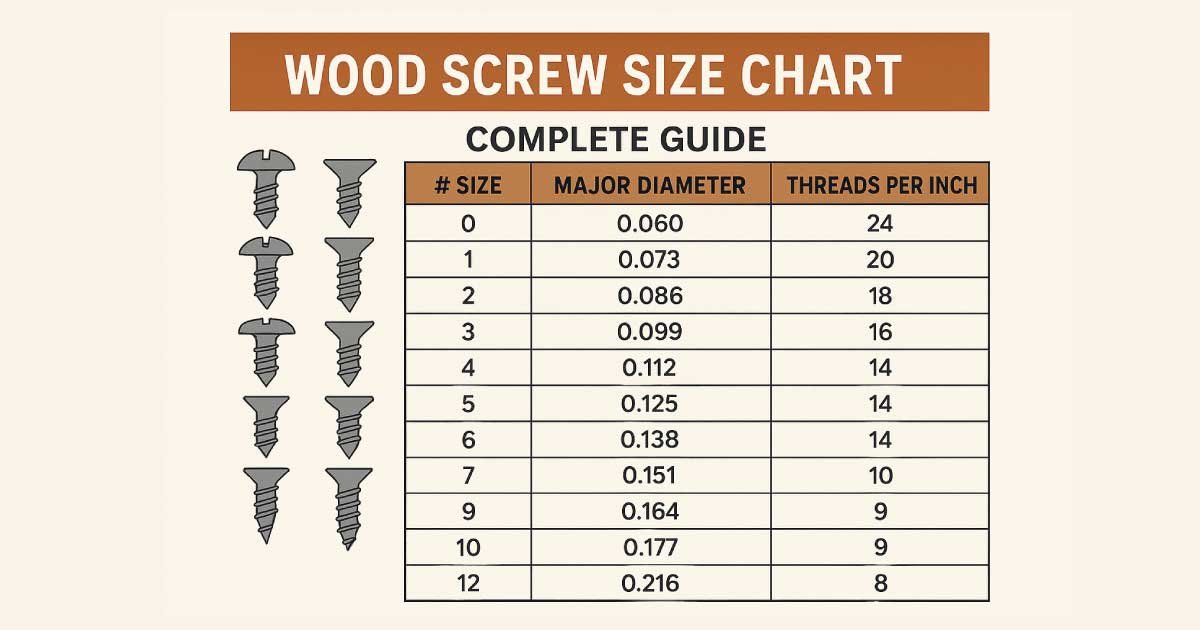When it comes to woodworking, one of the most important tools you’ll use is the humble wood screw. While they may seem simple, choosing the right screw for your project can make a big difference in strength, durability, and overall finish. That’s why a wood screw size chart is an essential reference for any DIY enthusiast, carpenter, or professional woodworker.
In this guide, we’ll cover the different types of wood screws, how their sizes are measured, and provide a detailed chart that makes selecting the right screw easy.
Why Screw Size Matters in Woodworking
Using the wrong screw can lead to:
Splitting the wood
Weak joints that may fail under load
Stripped screw heads or threads
Knowing the correct screw gauge, length, and thread type ensures your projects are strong, safe, and professional-looking. A wood screw size chart takes the guesswork out of your work, saving both time and materials.
Understanding Wood Screw Sizes
In the U.S., wood screws are sized by:
Gauge (Diameter)
Small screws: #2, #4, #6
Medium screws: #8, #10
Large screws: #12, #14
Length
Measured from the screw tip to the point where the screw head sits (countersunk) or the full length for round/pan head screws.
Thread Type
Coarse threads: Ideal for softwoods
Fine threads: Ideal for hardwoods, providing a tighter grip
Head Type
Flat Head (countersunk)
Round Head
Pan Head
Oval Head
Drive Type
Phillips, Slotted, Square (Robertson), Torx
Wood Screw Size Chart
Here’s a reference chart for common wood screw sizes, including gauge, diameter, length, and recommended pilot drill bit size.
| Screw Gauge | Major Diameter (inches) | Major Diameter (mm) | Common Lengths (inches) | Recommended Drill Bit (Softwood) | Recommended Drill Bit (Hardwood) |
|---|---|---|---|---|---|
| #2 | 0.086″ | 2.2 mm | 1/2″, 3/4″, 1″ | 1/16″ | 3/32″ |
| #4 | 0.112″ | 2.8 mm | 1/2″, 3/4″, 1″ | 3/32″ | 7/64″ |
| #6 | 0.138″ | 3.5 mm | 1″, 1-1/4″, 1-1/2″ | 7/64″ | 1/8″ |
| #8 | 0.164″ | 4.2 mm | 1″, 1-1/2″, 2″ | 1/8″ | 9/64″ |
| #10 | 0.190″ | 4.8 mm | 1-1/2″, 2″, 2-1/2″ | 9/64″ | 5/32″ |
| #12 | 0.216″ | 5.5 mm | 2″, 2-1/2″, 3″ | 5/32″ | 11/64″ |
| #14 | 0.242″ | 6.1 mm | 2-1/2″, 3″, 3-1/2″ | 11/64″ | 3/16″ |
Also Read:
How to Read Wood Screw Sizes
If you see a screw labeled #8 x 2″, it means:
#8 = Screw gauge (diameter)
2″ = Screw length
If it’s #10-24 x 1-1/2”, the 24 indicates threads per inch for a fine or coarse machine screw. For most woodworking screws, threads are coarse.
Tips for Choosing the Right Wood Screw
Match screw size to wood type
Softwood → coarse-thread screws for better grip
Hardwood → fine-thread screws to prevent splitting
Pre-drill holes when needed
Reduces the risk of splitting, especially with large screws or hardwoods
Ensures screws go in straight and cleanly
Select proper screw length
Screws should penetrate at least 2/3 of the thickness of the lower piece for strong joints
Use the correct driver bit
Avoid stripping heads by using the right Phillips, square, or Torx bit
Common Applications of Wood Screws
#4 & #6 screws → Small crafts, light fixtures, cabinetry
#8 screws → General woodworking, furniture assembly
#10 screws → Heavier furniture, decks, cabinets
#12 & #14 screws → Structural woodworking, outdoor decks, and large projects
Why a Wood Screw Size Chart is Important
Saves time: No more guessing which screw fits best
Prevents damage: Avoids splitting wood and stripping screws
Ensures durability: Provides strong, secure joints
Universal reference: Works for DIY, professional woodworking, and construction
Also Read:
Final Thoughts
A wood screw size chart is an indispensable tool for anyone working with wood. By understanding screw gauge, length, thread type, and pilot drill recommendations, you’ll ensure your projects are strong, precise, and long-lasting.
Keep this chart handy in your workshop, and next time you’re buying screws or starting a woodworking project, you’ll know exactly which screw to use. Whether it’s a small craft project or a large deck, using the right screw makes all the difference.

